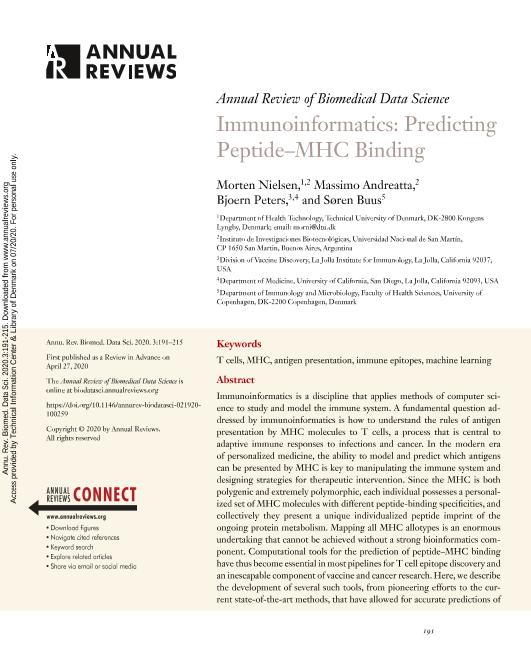Artículo
Immunoinformatics: Predicting Peptide–MHC Binding
Fecha de publicación:
07/2020
Editorial:
Annual Review
Revista:
Annual Review of Biomedical Data Science
ISSN:
2574-3414
Idioma:
Inglés
Tipo de recurso:
Artículo publicado
Clasificación temática:
Resumen
Immunoinformatics is a discipline that applies methods of computer science to study and model the immune system. A fundamental question addressed by immunoinformatics is how to understand the rules of antigen presentation by MHC molecules to T cells, a process that is central to adaptive immune responses to infections and cancer. In the modern era of personalized medicine, the ability to model and predict which antigens can be presented by MHC is key to manipulating the immune system and designing strategies for therapeutic intervention. Since the MHC is both polygenic and extremely polymorphic, each individual possesses a personalized set of MHC molecules with different peptide-binding specificities, and collectively they present a unique individualized peptide imprint of the ongoing protein metabolism. Mapping all MHC allotypes is an enormous undertaking that cannot be achieved without a strong bioinformatics component. Computational tools for the prediction of peptide?MHC binding have thus become essential in most pipelines for T cell epitope discovery and an inescapable component of vaccine and cancer research. Here, we describe the development of several such tools, from pioneering efforts to the current state-of-the-art methods, that have allowed for accurate predictions of peptide binding of all MHC molecules, even including those that have not yet been characterized experimentally.
Palabras clave:
T cells
,
MHC
,
Antigen presentation
Archivos asociados
Licencia
Identificadores
Colecciones
Articulos (IIBIO)
Articulos de INSTITUTO DE INVESTIGACIONES BIOTECNOLOGICAS
Articulos de INSTITUTO DE INVESTIGACIONES BIOTECNOLOGICAS
Citación
Nielsen, Morten; Andreatta, Massimo; Peters, Bjoern; Buus, Søren; Immunoinformatics: Predicting Peptide–MHC Binding; Annual Review; Annual Review of Biomedical Data Science; 3; 1; 7-2020; 191-215
Compartir
Altmétricas




